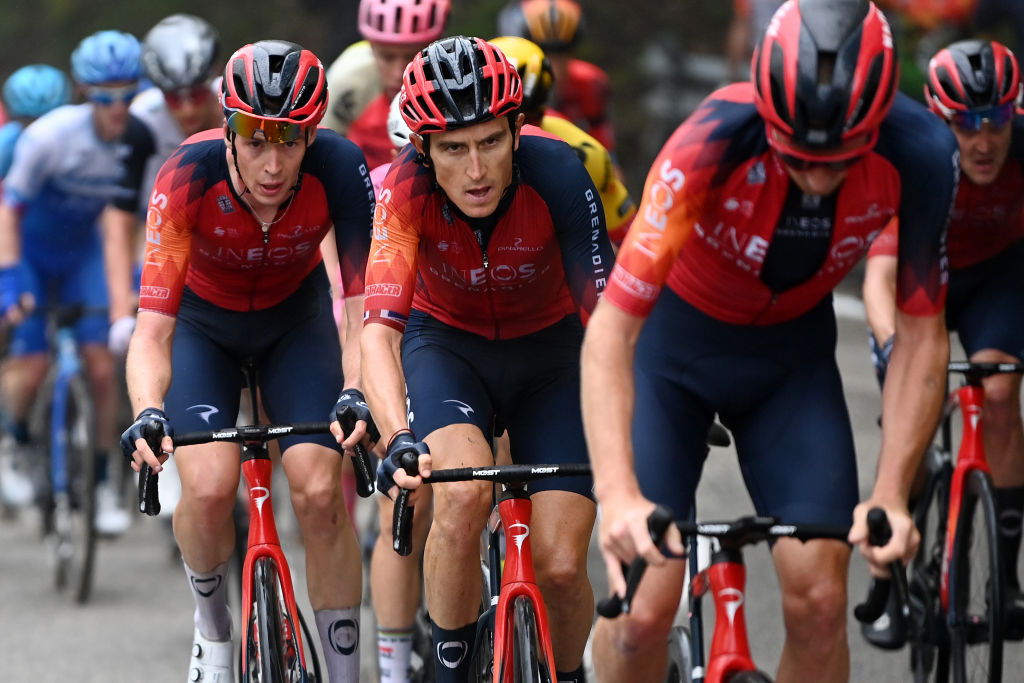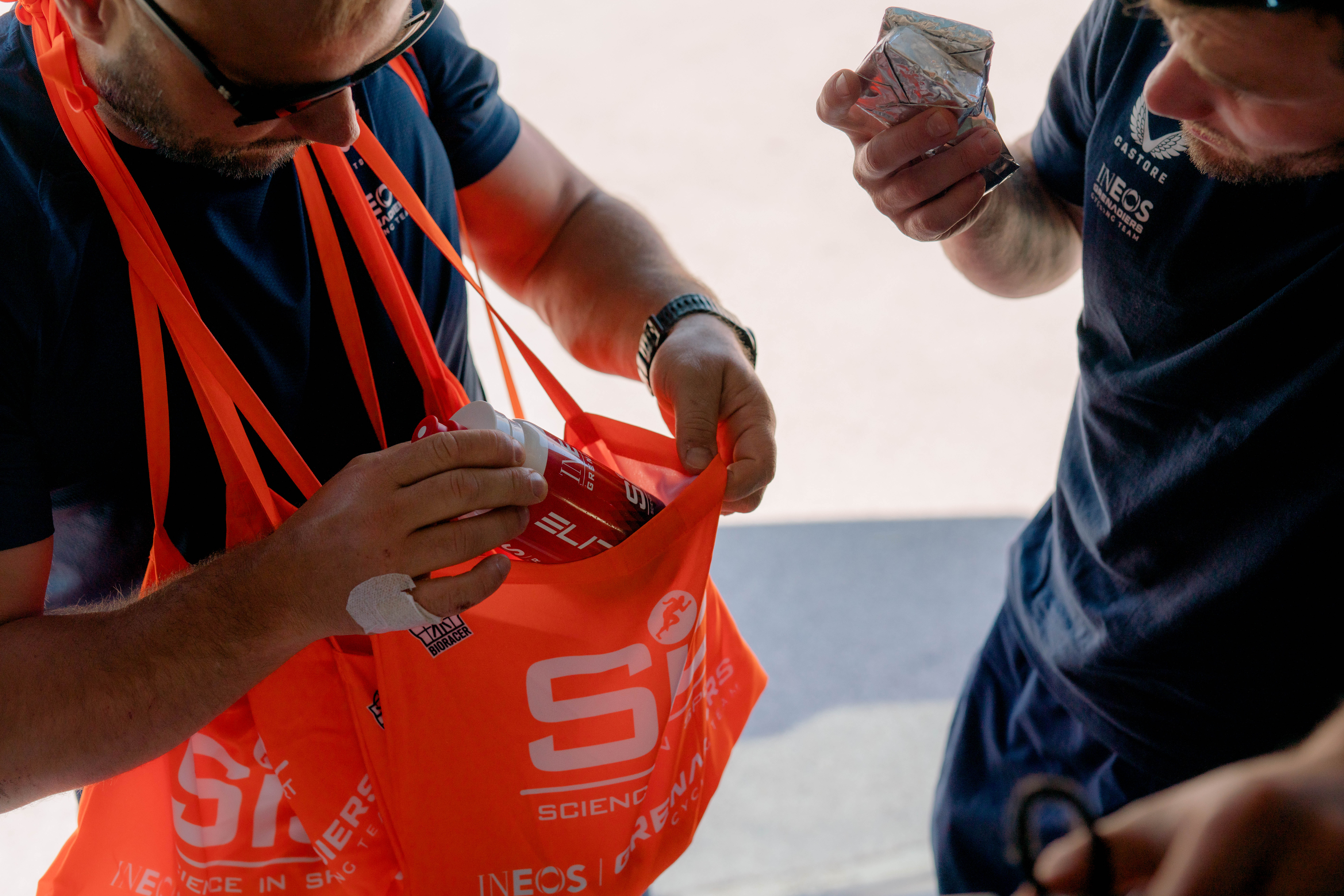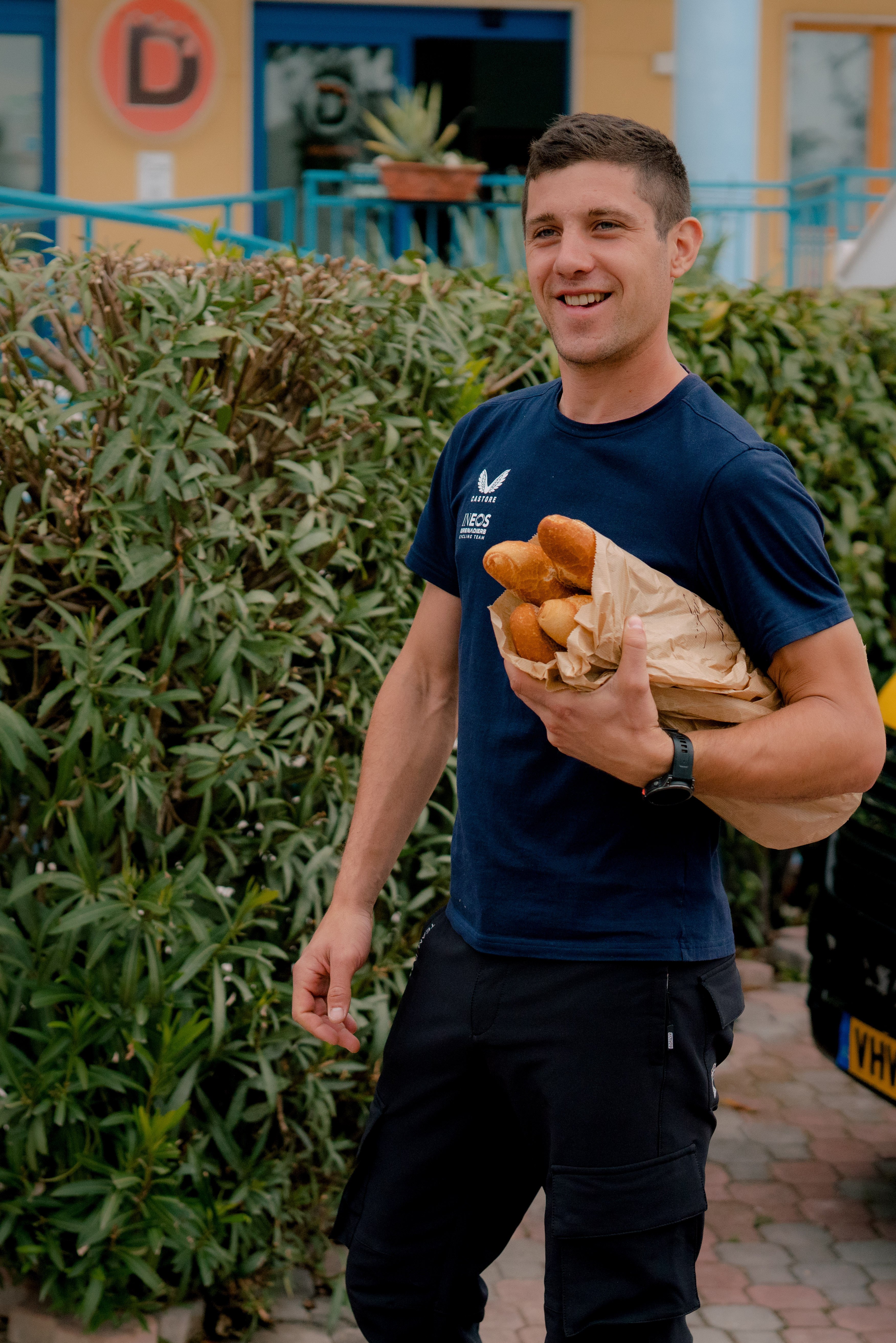
Taking place over the course of three weeks, a Grand Tour is a true test of endurance, and nutrition is absolutely central to the challenge.
To make it from Fossacesia to Rome to complete the 2023 Giro d'Italia, each rider will have to cover 3489.2 kilometres, which based on typical average speed and pedalling cadence, would require in excess of half a million revolutions of the pedals.
To make this happen, your average rider would take on and burn through more than 100,000 calories.
"A Grand Tour is a huge challenge for the gut," says Aitor Viribay, exercise physiologist and head of the nutrition department at the Ineos Grenadiers team.
"Some of the quantities we're talking about are insane. It's hard to actually get through that much food, but it's something you have to do."
The figure of 100,000 calories is based on the average intake across 21 stages, plus two rest days (which are never all that restful).
Certain stages are more energy-demanding than others. A big mountain day with huge elevation gain will clearly require more fuelling than a flat stage where most riders can shelter in the peloton. Meanwhile, there are three time trials in the 2023 Giro, the shortest of which, at 19.6km, sees the riders racing for less than half an hour.
"On a TT day, you could be down to 3000 calories per day," says Viribay. "For your average steady day - and there are no real easy days at a Grand Tour - it would be more like 6000. Then for a high mountain stage it could be around 9000."
A balanced diet?
A key part of the overall equation is how these calories are broken down by food group. It's no surprise that the biggest share goes to carbohydrates, with the likes of pasta and rice, along with a range of sugars, providing the lion's share of the fuel that powers the engines.
"With carbohydrates, we always talk in relative terms, which is grams per kilograms of body weight," says Viribay. "A normal amount is 10g/kg, which means 600 grams for a rider who weighs 60kg, and 700g for a rider who weighs 70g, and so on."
The other key component is protein, best known for its muscle-repairing qualities.
"Protein is very important, not only in recovery but also glycogen resynthesis," says Viribay, referring to the process of replenishing energy stores that have been depleted by exercise.
On top of those two big building blocks, there are a number of other ingredients required to see a rider through. Fat might be a skinny cyclist's worst enemy but healthy fats - found in the likes of nuts and avocados - are essential. Then there's the fibre that comes from fruit and vegetables, and the other micronutrients that come from an even wider range of foodstuffs.
"A healthy varied diet looks after gut health, and the immune system is an important consideration, especially now with COVID going around," says Viribay. "We try to match fuelling with a quality diet, proposing other foods like whole foods, vegetables, raw vegetables, fruit, salad, legumes, pro- and prebiotics - fermented foods as well.
"To put it simply, it's all about simple sugars on the bike and more complex foods off it."

A day in food
Breakfast
The first feed comes at the breakfast table.
"Breakfast can differ a lot depending on the stage. On a hard day, you'd want to keep it simple, whereas on a more relaxed day you can have something more complex," says Viribay.
"For a mountain stage, our riders would mainly eat rice, or sweet rice with some added sugars, then maybe some juice, jam, bread. On a steady day you could look at porridge, whole foods, more complex breads, and some fats through avocados or nuts. The harder the stage, the lower the 'quality' of the breakfast.
In-race
The riders will then travel to the start of the stage, sign on, sometimes warm up and then begin the day's racing. This is where fuelling is most vital.
Thinking has changed considerably over the years, with riders eating more than ever while on the bike. Milan-San Remo, the 300km Classic, always comes with tales of 6am pasta mountains, but in modern racing there is less of an emphasis on 'loading up' at the breakfast table.
"The majority of the daily carbohydrate intake is concentrated on the bike, so if we're doing 10g/kg, we'd do 6g/kg on the bike, and even higher on mountain stages. We do that because the bike is a much better environment for the metabolism. During exercise the fuel you put in goes more directly to the muscles."
In-race food comes in various forms. First of all, you have 'solids', which typically take the form of energy bars or rice cakes. Alongside that you have liquids and 'semi-liquids'. The former comes in the form of carbohydrate powder mixed into a bottle of water, while the latter is the well-known energy gel, which provide a quick boost of sugars that are easily absorbed.
"A big mountain stage can demand up to 16 or even 18g/kg of carbohydrates, which is insane," says Viribay. "We're talking up to 120g per hour, and around 10g/kg just on the bike. On an easy day, it can be more like 70 or 80 grams per hour."
Another area of received wisdom being challenged by modern cycling is the idea of stocking up on solids in the opening phase of the race before switching to liquids and gels later on.
"Nowadays, the intensity can go so high from the beginning, you often need gels already from the start," says Viribay. "It's still based on intensity, though. Generally, when the intensity is lower, we'd try to eat more, and more solids and complex foods. Then when the intensity is high, use more liquids and semi-liquids."
Post-stage
When the riders cross the finish line, the nutrition game is far from over. Attention turns to recovery and then, before too long, starting to fuel for the next day. Protein is widely known as the repairer of muscles but the strategy is still more focused on carbs.
"When it comes to recovery, our protocol is based on optimisation of glycogen replenishment," says Viribay. "What you want to do is put in as many carbs as possible, as quickly as possibly, as easily as possible. So that starts with liquids, then we move onto foods. The hours after the finish are critical. The muscles are so sensitive and it's a good opportunity to keep fuelling."
After returning to their hotel for the night, the riders will then congregate around the dinner table, where they'll tuck into more of a normal meal.
"Dinner is always based on the next day," says Viribay. "If we're expecting a big glycogen reduction, we want to maximise the glycogen stores, so - like with breakfast - it's a high-carb, low-fat meal. If it's an easier day coming up, it would be more complex, nutrient-rich foods."

Why the pros can eat all this - and why you shouldn't
If the sort of numbers being quoted here seem other-worldly, it's because they likely couldn't - and certainly shouldn't - be attempted by a non-professional.
Part of the beauty of cycling is that the routes used in the biggest races can be ridden by any amateur. With events like the Etape du Tour, cyclists can test themselves over a carbon copy of what is often the hardest and most spectacular stage of that year's Tour. However, this doesn't mean they should simply copy what the pros do.
"It's so important to spread good information and make sure people don't go crazy in trying to mimic the strategies we are implying here," says Viribay.
"There's a massive difference between professionals and even the stronger amateurs. These are elite athletes, and arguably the best capacity of a pro cyclist is the ability to create energy from food. Their mitochondrial function is so high, which means they can absorb, digest, and metabolise sugars very efficiently.
"Amateur cyclists will not have this same capacity. If you take a sedentary person, with a high carb intake, diseases can appear, such as diabetes. That's because their mitochondrial function is not ready to take all that sugar. You can say a similar thing here. Any amateur rider without that pro-level function cannot convert the same amount of food into energy, so even if they're riding the same distance, they shouldn't be eating the same amount."







